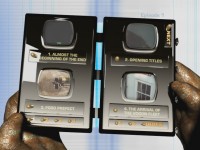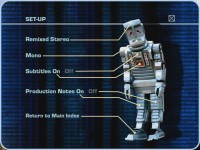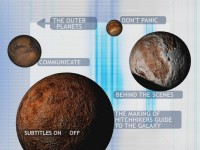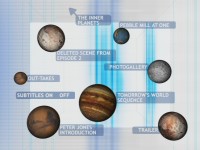
25.10.2014 #581
German Versions from
28.2.2002 & 18.10.2009 / #470
by Guido Bibra
• Don't Panic! - additional "Making of" material
• An introduction to the first episode by Peter Jones, recorded live at the NFI
• Communicate! - Behind-the-scenes of the radio series
• The original BBC2 Episode One trailer
• Deleted Scene
• Behind-the-scenes
• Tomorrow's World anamatronics feature on Zaphod Beeblebrox
• Outtakes
• Photo Gallery
• On Screen Production Notes
![]() The Serie
The Serie
It is Thursday, and Arthur Dent already has a feeling early in the morning that this is not going to be his day. His attempts to wake up are rudely interrupted by a bulldozer trying to knock his house down in favour of a motorway bypass - he is only able to stop the construction crew by lying in front of the heavy machinery. While arguing with a certain official called Mr. Prosser, Arthur's good friend Ford Prefect shows up and convinces him to join him at the nearby pub to be filled up with beer. Then Arthur realizes that this Thursday will be the strangest of his life when Ford explains that he is not from Guildford, but from a small planet in the vicinity of Betelgeuse and the Earth will be destroyed by Vogons to make room for a hyperway expressroute. In literally the last moment, Ford Prefect manages to transport them on board the Vogon spaceship. In his profession of being a roving reporter for the Hitchhiker's Guide to the Galaxy, this does not present much of a problem for him - but Arthur is really lost when he arrives in the hold of an alien spaceship together with his friend, who tells him his home planet has been destroyed ...
The legend says that everything began in a field in Innsbruck, when a young man called Douglas Adams had the idea of a galactic space travel guide for hitchhikers, when he was hitchhiking himself almost without a penny through Europe. The concept was soon forgotten while Adams was busy studying in Cambridge, but he mostly joined theatre and comedy groups like the Footlights. He never was entirely happy there, although he did meet people like Graham Chapman, which later brought about a short-lived collaboration on Monty Python's Flying Circus. Adams had not yet made his breakthrough as an author at this point - until his good friend and occasional flatmate John Lloyd was able to give him a job in the BBC's radio department.
Radio Days
Lloyd had introduced Douglas Adams to radio producer Simon Brett, who first assigned him to write a couple of sketches for the comedy series The Burkiss Way. Soon, Brett recognized that Adams' talent for weird satire would be able to work much better on an own platform and offered him his own radio series at the beginning of 1977. Douglas Adams already had an idea for a comedy science fiction series for a long time and proposed a concept called Ends of the Earth, which would demonstrate in six episodes six ways how the Earth could be destroyed. While looking for a protagonist and narrator, Douglas Adams remembered his old idea of The Hitchhiker's Guide to the Galaxy - why not use an extraterrestrial reporter for a galactic travel guide?
In Spring 1977, Douglas Adams got the green light for a first pilot episode, which was recorded in Summer of that year. While The BBC program makers did not yet really know what to make of this strange science fiction satire, they still gave The Hitchhiker's Guide to the Galaxy a chance and made the production of five more episodes possible, which were first broadcast in early 1978. Despite a bad timeslot and practically no promotion, the series became an insider tip among BBC listeners. Thanks to Douglas Adams' crazy ideas, the great help of producers Simon Brett and Geoffrey Perkins plus the sound creativity of the BBC Radiophonic Workshop, the series became a surprise success. After a long pause and the publication of the first book, which was based on the first four radio episodes, first a Christmas special was produced at the end of 1978, which was followed by five more episodes in early 1980. They were the last episodes of The Hitchhiker's Guide to the Galaxy radio play, but even during their making a whole new project had begun.
Television Overture
Douglas Adams had been extremely busy since the Hitchhiker's Guide radio play had taken shape and his first book was published - and he also worked on some scripts of the science-fiction television series Doctor Who. But at the end of 1979, he got even busier: John Lloyd, who in the meantime had gone from radio to television at the BBC, managed to convince the program makers to make a television series out of the actually thought to be unfilmable Hitchhiker's Guide to the Galaxy. With a successful radio series, a best-selling book and even some stage adaptions under the belt, John Howard Davies, the head of BBC's light entertainment department, could not say no to a television adaptation of the Hitchhiker's Guide. Encouraged by his experience with the Doctor Who writing team, Douglas Adams wrote a new, ambitious script for a pilot film, combining the playfulness of the radio series with the visual medium television, making the most of the technical possibilities at the time.
Douglas Adams' creativity was, however, somewhat curbed by the assigned director Alan Bell, who did not like the hours-long tinkering of the radio series at all. In British television, the job of a director was quite different than in the film business and almost only on the technical side, having the often unpopular job to bring a production in on time and on budget. Douglas Adams was not in favour of this modus operandi at all, but he had no other choice as to cooperate with Alan Bell. At least he knew about the technical possibilities very well and despite initial doubts knew exactly how to visually interpret the radio series. But there was another collision when it came to the casting: while Adams wanted to take over all the actors from the radio series, Alan Bell wanted to recast all the roles.
Earthmen and Aliens
In the end, the author and the director settled on a compromise causing the recasting of only two roles, neither of them the main character of Arthur Dent. Douglas Adams had cast him in the radio series with Simon Jones not by accident, but with him in mind since he had written the first lines of the script. The actor was the perfect incarnation of a typical British everyman and knew his role already so well that he was able to become the one and only Arthur Dent not only on radio, but also on television. His character was not changed at all, but Douglas Adams had never given much thought about his outward appearance in the radio series and the first books. Therefore, the now legendary combination of pyjama and dressing gown became one of the most original inventions of the television series, which was later incorporated by Douglas Adams into his books and became an integral part of the character.
Less lucky was Geoffrey McGivern, who played Arthur's extraterrestrial friend Ford Prefect in the radio series - the actor simply didn't look like someone coming from a small planet in the vicinity of Betelgeuse and there was no way around a recasting. But Alan Bell had found an ideal replacement, someone who even Douglas Adams was happy with: David Dixon, a very busy English actor, who was not only chosen because of his very unique face, but also because he came very close to the original Ford Prefect. With the help of turquoise contact lenses and a colourful, cobbled-together, but still elegant costume, David Dixon was able to make the most of his role as an intergalactic roving reporter and hitchhiking specialist, taking great care of embodying Douglas Adams' very special humour and being a perfect partner for Simon Jones, whose many joint scenes became one of the biggest strengths of the television series.
Susan Sheridan was not a victim of the negotiations between the director and the author, but was unable to make the series because of other commitments, although she would have been a perfect representation of her character Tricia McMillan. Unfortunately, the recasting of the role became one of the biggest disappointments of the series, because both Alan Bell and Douglas Adams had chosen someone entirely wrong for the role of "Trillian", who was described in the radio play and in the books as very intelligent and intellectual. Instead, the American actress Sandra Dickinson was cast, a small blonde with a high voice, who looked more like an intergalactic Marilyn Monroe than a mathematician and astrophysicist. This may have been a deliberate attempt of Douglas Adams to make the role more glamorous, but it ended up being extremely out-of-character. The wardrobe choices were part of the problem, because wedged into a very revealing costume the actress looked visibly uncomfortable and also had to deal with the weakest dialogue of the script, which Douglas Adams had heavily shortened and simplified, reducing her character almost to a caricature.
Two-headed Presidents, Robots and a Talking Book
Douglas Adams had already made a lucky find when casting Mark Wing-Davey for the radio series as Zaphod Beeblebrox, who brought exactly the right slimy frivolity to the character. The outrageous, arrogant, egoistical but still sympathetic space cowboy was also played by him in the television series in exactly the same way, but there was a huge problem: in the radio play, Douglas Adams had given him a third arm and a second head, which was, of course, no problem on radio, but created huge headaches on television. The third arm was relatively uncomplicated, but the second head was elaborately and expensively built as an animatronic contraption, which never really worked well and looked very artificial. But Mark Wing-Davey was not stopped by these problems and still had a lot of fun with Zaphod Beeblebrox, who became one of the most memorable characters of the series.
Zaphod Beeblebrox was not the only character making a transformation from radio play to television series difficult - there was also Marvin, the paranoid android. In the radio series, he was made out of the unmistakable voice of Stephen Moore and a handful of sound effects, but for television, a real-life robot had to be created. The BBC designer department had really created a life-size robot, who actually looked rather conventional and almost seemed like a toy, but on the other hand matched the description of a mass-produced "Plastic Pal who's fun to be with!" astonishingly well. The Robot was, of course, not remote-controlled, but just a costume inhabited by David Learner, who had played the role before in several stage adaptations and already had his robot moves figured out. While he spoke all of Marvin's lines on the set, his voice was replaced in post-production again by Stephen Moore, who was so much linked to the character that there was no way around casting him - something which David Learner was entirely happy with himself.
Another very well known voice was also a holdover from the radio series: Peter Jones, the voice of the book, had one of the most important roles in the play and was already inextricably linked to the Hitchhiker's Guide to the Galaxy. Originally, Douglas Adams was just looking for someone who sounded like Peter Jones and almost never asked the actor himself, who was luckily available for the radio series after all. With his wonderfully dry British voice, he was perfect as the narrator of the intergalactic travel guide, but he had exactly the same job in the television series as on radio: to provide his voice, because he never appeared on camera. Despite being still invisible, he still was as integral to the television version of The Hitchhiker's Guide to the Galaxy as he was to the radio incarnation.
Hitchhiking on to the Television Screen
Douglas Adams had based his scripts for the six planned television episodes loosely on the radio series, but he had rewritten large parts of the last two episodes and heavily revised the rest. Some things from the radio series just did not work on television, other elements had to be scrapped for budget reasons or changed, but overall Douglas Adams was able to improve the so far second version of his story. He had already used many of this ideas in his first two books The Hitchhiker's Guide to the Galaxy and The Restaurant at the End of the Universe, which roughly covered both the plots of the radio and television series, but were actually a separate third version of the Hitchhiker saga.
At first, the BBC commissioned a pilot episode, which was recorded between March and July 1980 and after some very successful test screenings, during which a thankfully never used laugh track was recorded, the BBC was thoroughly convinced by the series and gave a green light for the production of the five other episodes. After a few months pause, the production was able to start again in September 1980 and had to work really fast, because the premiere was already slated for January 1981. This resulted in a very hasty and quick filming process, which was especially frustrating for Douglas Adams and the actors, because the director was very anxious to work as fast as possible and without straining the budget.
Computer Graphics from the Drawing Board
One of the biggest questions during the transformation from radio play to television series was how to implement the voice of the Hitchhiker's Guide. In the radio version, the narrator had the very important task to talk about things the listener had to imagine, but on the television screen, this concept was a whole other problem. Douglas Adams had very early decided on a visual representation of the Hitchhiker's Guide, which would have meant computer graphics. But in 1980s, this was not remotely possible yet and at first the whole idea was scrapped in favour of just a voice-over narration until Douglas Adams had the idea to use traditional hand-drawn animation to emulate a computer screen output. To keep the costs down, the texts of the guide would have to be mixed with real footage, but this still presented a huge challenge.
Alan Bell had tasked the BBC animation department with a hand-drawn test animation, which turned out so bad that it was virtually unusable. At the same time, the director had come across Rod Lord's Pearce Studios by chance, a group of young, inventive animation experts, who had every confidence that they were able to bring Douglas Adams' texts to life on the screen. The trick was to create traditional animation that looked like it was produced in a computer - Rod Lord and his team were able to demonstrate exactly this in a short test sequence about the babel fish entry in the Hitchhiker's Guide in such an impressive way that they immediately got the job to produce the graphics for the complete series.
With the crisp line drawings and moving text entries on a black screen typical for early 1980s computers, the hand-drawn animations were so amazing that the BBC was often asked which fantastic machine was used for the graphics - even many computer experts were fooled by the imitation. Over thirty years later, the handmade computer animations still look astonishingly modern and even accurately predicted today's powerpoint, flash and webdesign craze. The idea of the Hitchhiker's Guide as a portable electronic book was literally three decades ahead of its time and while it was completely utopic in 1980, it would become real much faster than anyone would have imagined at the time.
Spaceships, Restaurants, and Planet Factories
While the handmade computer graphics were literally state of the art, the set design was somewhat limited because of the low television budget. The BBC production designers Andrew Howe-Davies and Tom Yardley-Jones, who had already garnered some experience on a couple of Doctor Who episodes, still made a huge effort under the circumstances and designed the sets in a both efficent and original way. Less was often more and much was still left to the imagination, but what was shown often had the slightly rustic charm under which Doctor Who also suffered as the only other science fiction series of the BBC. But even with these limited possibilities, the set design was still full of creativity and brilliant ideas with the unmistakable signature of Douglas Adams.
Many of the sets had also been extended by the venerable technique of matte painting, combining real footage with painted backgrounds. While this is usually done on film or in camera with glass plates, here a video mixer from Quantel was used to create then-revolutionary image manipulations with relatively low effort. The usage of "virtual sets" was so extensive that some of the actors who were not used to work in front of blue or green screens had trouble imagining the scenery that was only later created in post-production. A special luxury was afforded for the special effects, for which a whole day of recording was set aside - something no other BBC series was allowed at the time. The model shots of the spaceships and some other elements suffered the most from the low budget and despite visible efforts to make them look good they are far less convincing as the sets themselves.
In the Silence of Space
What had originally begun as a radio play had to sound at least as good and sound editor Michael McCarthy again called for the services of Paddy Kingsland of the BBC Radiophonic Workshop, who already had created the unique world of sound of the radio series and was absolutely essential for the television adaptation. Kingsland was mainly responsible for creating the sound and music for the Hitchhiker's Guide entries, which he underlaid with a completely new combination of electronic noises and synthesizer music. In the radio play, this was not yet very pronounced and mostly stock music was used, but in the visual adaptation of the guide entries the sound accompaniment had a much more important role, with music and sound effects being synchronized to the image in every little detail.
While Paddy Kingsland was working on the completely new background score, the title music could not be replaced that easily because Douglas Adams had already found his favourite, which he did not want to abandon. While searching for a theme that simultaneously embodied science-fiction and hitchhiking, the author stumbled upon a until then relatively unknown instrumental from The Eagles called Journey of the Sorcerer, which used both a banjo accompaniment and a futuristic synthesizer melody lead among guitars and even an orchestra. For the radio series, the BBC was able to use the original 1975 recording, but for the vinyl album versions of the first four episodes a new version had to be recorded, which had been arranged by Tim Souster and was also used for the television incarnation. But nevertheless in which version, Journey to the Sorcerer had become one of the biggest trademarks of The Hitchhiker's Guide to the Galaxy.
Hitchhiking the Airwaves
The first episode of The Hitchhiker's Guide to the Galaxy was premiered on January 5th, 1981 on BBC2 in the 9pm prime time slot and the reactions of both viewers and critics were similarly positive and enthusiastic. After the broadcast of the next five episodes in weekly instalments, the adventures of Arthur Dent, Ford Prefect, Zaphod Beeblebrox and Tricia McMillan had become an instant classic. Following the radio series and the first two books, the characters now not only had voices, but finally faces and the strange universe of the Hitchhiker's Guide had been visually created for the first time in a most unique and original way. Especially highly praised were the pioneering (but still hand-drawn) computer graphics, the very likeable actors and the distinctly noticeable satiric undertone.
Some, however, missed the special magic of the radio series - among them was Douglas Adams himself, who was not really satisfied with the sometimeshasty and not very thorough production and quite justly blamed director Alan Bell for not having enough love for detail. Originally a second television series based on Douglas Adams' never filmed script Doctor Who and the Krikkitmen was planned, but the author did not want to work with the director again and when the BBC insisted on it, the project never materialized. Instead Douglas Adams rewrote his script into his third Hitchhiker book Life, the Universe and Everything, while the series remained the only television and even radio incarnation of the Hitchhiker's Guide to the Galaxy for a long time. Simon Jones and David Dixon, however, both appeared as themselves and their characters in the 1993 Making Of The Hitchhiker's Guide to the Galaxy and also in a television documentary from the South Bank Show about Douglas Adams.
Over thirty years after its premiere, the television adaptation of The Hitchhiker's Guide to the Galaxy still remains the ultimate visual representation of the material despite the low production values and a blatant miscasting, giving the characters their definitive personalities and bringing the story to life in a wonderfully satiric way. When Douglas Adams died on May 11th, 2001 from a sudden heart attack, the author had been working creating a long-planned cinema version of The Hitchhiker's Guide to the Galaxy and even thought of continuing the radio series - but all this seemed to come to an end after his tragic death.
But in 2004 and 2005, Simon Jones, Geoffrey McGivern, Mark Wing-Davey and Susan Sheridan returned to the BBC sound studios for a radio adaptation of Douglas Adams' further Hitchhiker stories, which up to this time only existed in book form. The scripts were written by Dirk Maggs, John Langdon and Bruce Hyman with the blessing of Douglas Adams' estate and the help of the author's own notes. Although the actors had since become too old to visually represent their roles, their voices remained almost unchanged and they were able to almost seamlessly slip back into their characters. In 2005, the long-awaited movie version of The Hitchhiker's Guide to the Galaxy was also completed, which brought the old ideas with a new cast to the big screen - it was again a completely different incarnation of the story, but still a very successful adaptation in the spirit of the original. But despite its technical inferiority, the original television series from 1981 still remains the best visual representation of The Hitchhiker's Guide to the Galaxy until today.
![]() The DVD
The DVD
The Hitchhiker's Guide to the Galaxy had been first released on Laserdisc in the mid-1980s by the BBC, but because of the sale of the film rights, this was only short-lived and only in 1992 the series was finally released on VHS in England and several other countries. It took, however, almost five years from the introduction of the DVD for the series to make it onto the new digital format, but in 2002 the BBC had finally released The Hitchhiker's Guide to the Galaxy - it was worth the long wait, because every effort had been made to make the DVD as good as possible.
For the first time all six episodes were seen in their separate, uncut versions, because for the VHS release of 1992 three episodes each were cut together into two films. The image quality was improved as much as possible and both the original mono sound mix and the newer stereo remix were included. For the bonus materials, the BBC had also spared no effort and prepared an amazing collection of extras, among them Kevin Davies' wonderful 1993 Making Of and a lot of other archive materials. The two discs were packaged in an elegant digipack housed in a sturdy cardboard sleeve with a great cover design.
The DVD reviewed in this article is the first edition of the British BBC release from January 2002, which was replaced in 2005 by an identical new version containing the same discs, but now packaged in a keepcase. The DVDs were also released in the USA in April 2002 by the BBC with an additional documentary about Douglas Adams, but since the PAL-NTSC conversion degrades the image quality, this edition is not recommendable. In Germany the series was also released in 2002 by Universum, but the cut German television masters were used with each episode having more than five minutes removed - even though the original soundtrack was also included along most of the bonus materials, these discs were a huge disappointment, making this UK BBC release the best version of the series even until today.
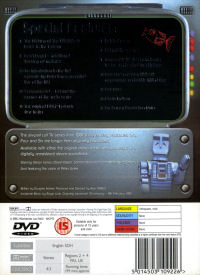
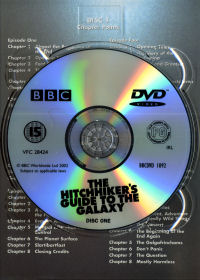
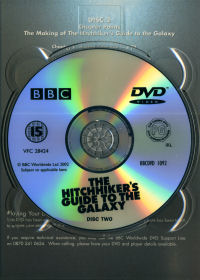

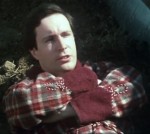
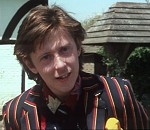
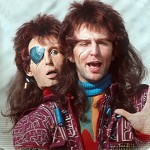
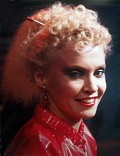
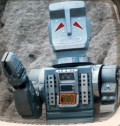
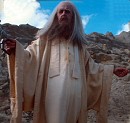
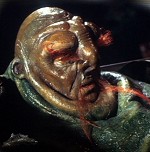
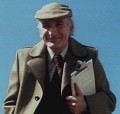


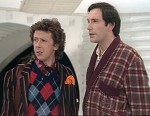
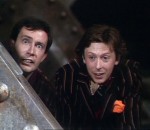

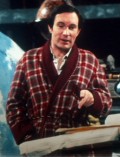
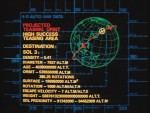

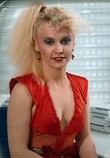
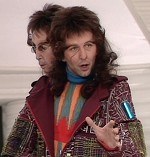
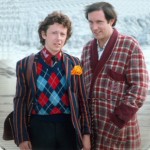
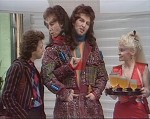
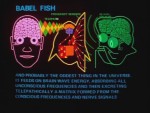
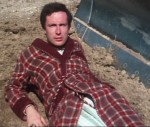
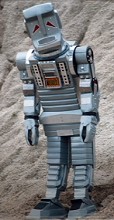
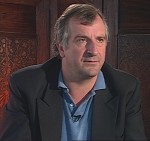
![]() Image
Image
At the beginning of the 1980s, it was still usual practice for BBC television productions to shoot on video in the studio and on 16mm on location, while all the editing was done on video. There were only few exceptions and The Hitchhiker's Guide to the Galaxy was unfortunately not one of them. Because the series made heavy use of video mixers in post production, the final master only exists on videotape, which in this case was the 2-inch Quadruplex format still in use at the BBC until 1983. For this reason, the image quality has visible technical limitations, but thanks to a careful remastering actually looks quite good considering the circumstances.
The scenes shot on video have a surprisingly clean and stable look, only suffering from a slightly reduced sharpness - but detail is still on a good level for a video production from 1980. Colours also look surprisingly good and are remarkably noisefree, especially in contrast to the very murky looking VHS release from the 1990s. Because it was heavily mixed with the video elements, the 16mm film material could not be re-transferred, causing it to look noticeably less sharp than the video sequences. Most of the film grain was swallowed by the ancient transfer technology, but some mushy noise is sometimes still visible especially compared to the cleaner-looking video material. The film sources are relatively clean and only show occasional small dust and the odd scratch, but nothing major except for an occasionally slightly wobbly image.
The image is encoded interlaced, but plays well even with a simple de-interlacer on progressive displays.
The hand-animated computer graphics of the Hitchhiker's Guide had also been animated on 16mm film and transferred in post-production to video, but do not nearly look as problematic as the live-action film footage. Although the image is not always completely stable and sometimes moves about a bit, sharpness is excellent and does not swallow any details. The strong colours on the black background are reproduced very well, but exhibit a little granularity, almost looking like typical composite dot crawl. This is usually not a problem with quad videotape and does not appear in other image elements, so it actually seems to be film grain. Even with the small imperfections, this still looks a lot like computer graphics even today.
Despite the age-related problems, The Hitchhiker's Guide to the Galaxy has never looked better than on this DVD - there is simply not much more to be done with this type of material and the BBC had made every effort to make the series look as good as possible under the circumstances. Only the authoring could be a little better, because 200 minutes squeezed onto a single disc means a somewhat low bitrate of less than 5 mbit/s, which is thankfully mostly concealed by the not especially detailed material.
![]() Sound
Sound
To be true to the original, The Hitchhiker's Guide to the Galaxy had been created with a soundtrack that rivalled its radio predecessor. This DVD contains both the original mono mix and the later created stereo remix.
The Hitchhiker's Guide to the Galaxy had originally been mixed only in mono, because there were no television broadcasts with stereo sound in the UK in 1981. The mono soundtrack leaves a solid impression, but sounds slightly tinny with a noticeably reduced dynamic and is a little disappointing in comparison to the radio series. At the end of the 1980s, a new stereo mix was prepared for a short-lived laserdisc and later VHS releases, which was not only a faux upmix, but a completely discrete remix from multi-track masters in the style of the radio series.
For this reason, the second stereo soundtrack on this disc sounds much better and does have all the playfulness of the radio original, complementing the visuals perfectly. The mix is, however, slightly unconventional - while music and sound effects are heard in finest stereo with often directional effects, the position of the voices is sometimes very unusual. While the actor's dialogue is mostly centred in the middle, Peter Jones' voice-over is always mixed completely in the right or left channel, making this mix a little unusual. Playback through a ProLogic decoder is possible and sounds astonishingly good, but because of the odd voice placements there is some unintentional leakage on the surround channel. There are some subtle differences between the two track, but nevertheless the stereo mix is the best choice on this DVD because it reproduces the sound of the radio series so well.
There are English subtitles available, but these are sometimes inaccurate and even incomplete, something which was typical on many BBC DVDs in the early 2000s.
![]() Bonus Materials
Bonus Materials
The BBC had made a big effort with the extras, but this was mainly possible because there was already a lot of material around. An extensive documentary and many other never before shown jewels from the archives are only part of the excellent bonus material, presented in an elaborate menu design.
Unfortunately, there had been no chance to record an audio commentary with Douglas Adams before his untimely passing and there would have been the question if he really would have wanted to record one. Instead, Kevin Davies, who also produced the documentary, had prepared Text Commentaries for all episodes with detailed production notes, providing a huge amount of scene-specific information, some of which was even unknown to the biggest Hitchhiker fans. The somewhat impresonal presentation is a bit dry and academic - not unlike the Hitchhiker's Guide itself! - but next to a spoken commentary this is extremely well done and very interesting.
The Making of the Hitchhiker's Guide to the Galaxy (58:34) was produced in 1993 by Kevin Davies and was previously available on Laserdisc and VHS, but had never been shown on television. Behind the unassuming title there's an excellent documentary about the roots, evolution and making of The Hitchhiker's Guide to the Galaxy in both the radio, book and television incarnations. In many interviews, Douglas Adams, actors Simon Jones, David Dixon, Susan Sheridan and Mark Wing-Davey, director Alan Bell and many other of the production staff talk frankly about the sometimes not altogether unproblematic creation of the series and take a critical look back - but there is no animosity or regret and even the author himself acknowledges that despite the problems, the series was in many ways a success. The very special part of this documentary is that Simon Jones and David Dixon reprised their roles as Arthur Dent and Ford Prefect in a little embedded story and new computer graphics - this time really computer-generated - were produced with Peter Jones narrating again. This is as close to a continuation of the original series as it gets.
Don't Panic (26:02) contains more material that was left over from Kevin Davies' documentary and is seen for the first time on this DVD. It is not thrown away junk but simply another half hour of interviews and archive material, specially edited together for the DVD by Kevin Davies, making the main documentary almost one and a half hours long.
Communicate (10:28) is not about the television series, but a ten-minute featurette about the production of the radio play, giving the viewer the rare chance to watch the actors and sound technicians at work. The culmination of this mini-documentary is the solution to the problem of having to create a choir of robots - something which has been entirely left out in the television series and is only present in the radio series and books.
Behind the Scenes (7:19) has a somewhat confusing title, because this contains the last seven minutes of a very stessful studio taping session - including an on-screen clock as time-stamp. The scene had to be finished at a quarter past ten, because then the BBC technicians cut off the power. Despite the heavy tension, the scene from the end of episode 2 has become very funny in the final version.
The Deleted Scene from Episode 2 (2:13) shows that probably only the uncut tapes from this part of the series have survived, because all the previously unseen studio recordings are from this episode. Parts of this scene, which is not particularly important but nice to see anyway, have also been used in the documentary.
The Outtakes (9:14) are actually not studio-bound material, but 16mm location footage with flubbed takes which are not quite as funny as one could imagine - the tension is noticeable, but the actors still seem to have had at least a little fun. Remarkably is the good quality of these scenes which show how good a new transfer of the 16mm material could have looked
Pebble Mill at One (6:35) is an excerpt from the BBC program of the same name with director Alan Bell and animator Rod Lord as guests. The interview is mainly about the then very exciting animation technology, but there are also some explanations about the evolution of the project itself. This is a fascinating historical document, which was recovered from a private videotape recording because the BBC had wiped the original from their archives.
Tomorrow's World Sequence (2:27) is another rarity from the BBC archives - a short, but fascinating excerpt from the technology program depicting the wonders of Zaphods artificial second head. This sounds immensely complicated, but the contraption was actually only a hasty patchwork of electronics which never really worked and only was really used in very few sequences.
The Peter Jones Introduction (8:28) is the only in-person appearance of the Hitchhiker's Guide voice, which was shot as an introduction for a screening of the pilot episode for an audience of fans to record the thankfully never used laughtrack. All that is left from this misguided endeavour to make the series more comedy compatible is this wonderfully humorous appearance from Peter Jones.
The Trailers (2:32) contain the BBC trailer of the series for the first episode and five short announcement cards with spoken text.
The Photo Gallery has 67 images, which have been embedded into a somewhat unfavourable menu design, but are not simple screenshots, but real still photographs from the shooting.


